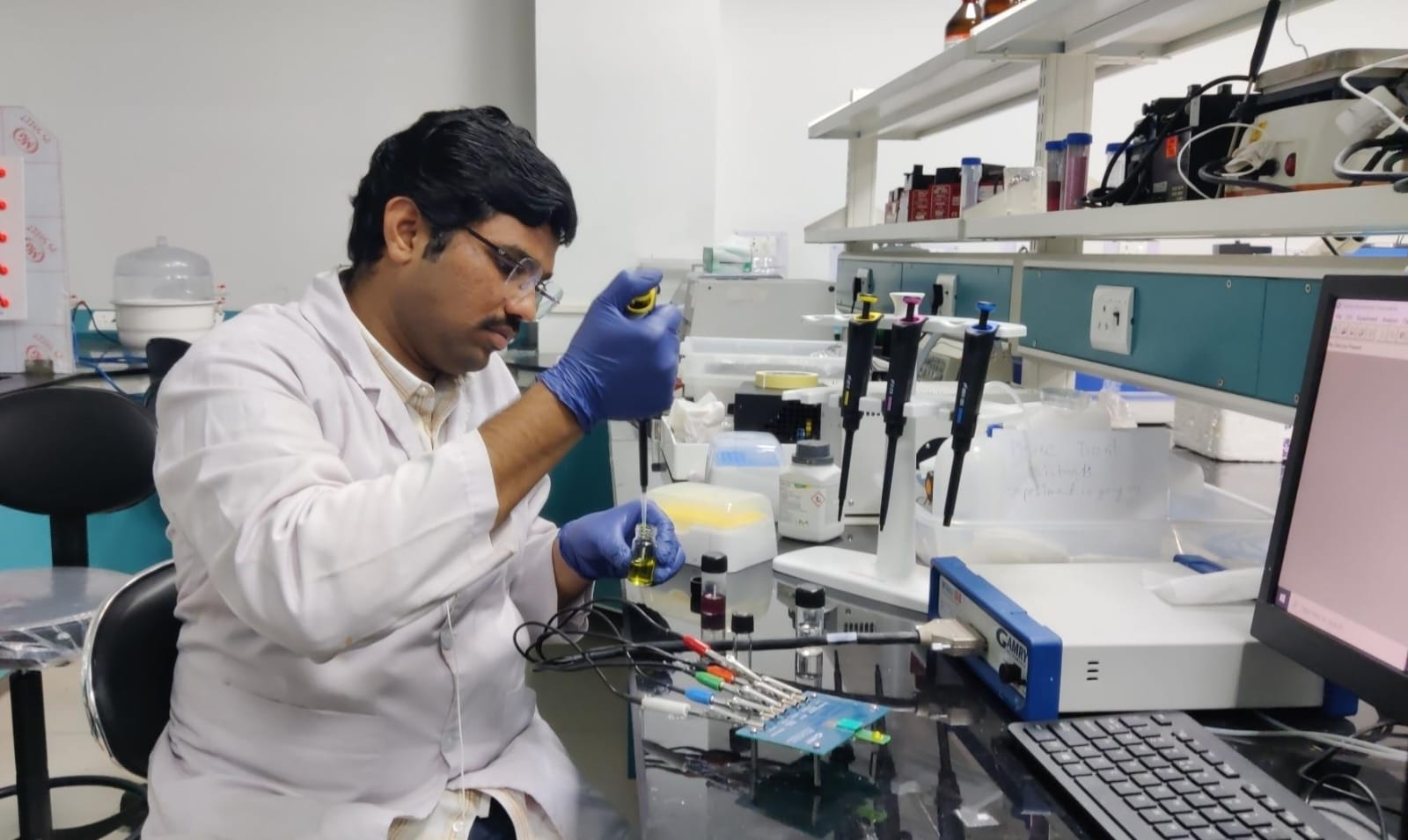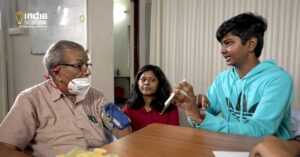IIT Guwahati Invents Sensor That Helps Diabetics Choose Low Glycemic Index Foods
An IIT Guwahati team, led by Professor Dipankar Bandyopadhyay, has developed a device that detects the glycemic index in food items in minutes. This will help diabetics manage their blood sugar levels.

Nishita (40) was diagnosed with diabetes more than eight years back. Over the years, through childbirth, postpartum and various stages of her career, the young banker based in Mumbai dealt with fluctuating blood sugar levels.
To regain some control over her health, she started with just a workout but found it hard to control the sugar spikes. Working with a dietician and doing a deep dive into what is really needed to manage life as a Type 2 diabetic, Nishita found the secret sauce to be a combination of working out, a rich diet, and managing stress.
Now her day starts with a 45-minute walk/run, followed by a breakfast of millet upma/dosa/idli with a glass of black coffee. Lunch is a jowar/bajra bhakri (flatbread) with a large amount of salad, dal and subzi (cooked vegetables).
She keeps her dinner light, with soup, salad and an occasional whole wheat roti/brown bread or some quinoa. Staying away from our usual staples like rice/whole wheat roti (flatbread), and completely avoiding junk food and sugar, has helped her keep her blood sugar under control, she says.
Like Nishita, several Indians live with diabetes every day, making India infamous for being the ‘diabetes capital’ of the world.
A recent study published in The Lancet Diabetes and Endocrinology found that India has more than 101 million people living with diabetes. Another concerning finding in the Indian Council of Medical Research–India Diabetes (ICMR-INDIAB) study was the fact that 15.3% of the population is pre-diabetic.
As is the case with many illnesses, diabetes is directly linked with being a lifestyle disease, which is often an outcome of poor diet, work-life balance other than being genetic. The key to managing such diseases is managing its symptoms and our approach to it.
The Glycemic Index (GI) is a rating system used to classify foods that are safe to eat from a blood sugar perspective. It is a measure of how quickly a food can make your blood sugar (glucose) rise.
To help diabetic patients live an easier and stress-free life, the researchers from the Indian Institute of Technology, Guwahati (IIT-Guwahati) have developed a device to instantly detect the glycemic levels in food. This sensor can determine the GI of different food sources in real-time which is crucial for diabetes management.
“Disease management becomes crucial, and an important part of that, especially for diabetics, is knowing the glycemic index of what they eat,” says Professor Dipankar Bandyopadhyay of IIT Guwahati, one of people from the research team behind this important innovation of the department of chemical engineering, along with Prathu Raja Parmar, who explained to The Better India what went into this Point-Of-Care-Testing (POCT) prototype.
How the sensor took birth

In 2014-15, Nestle India was in a soup when food safety regulators found that Maggi Noodles had high levels of monosodium glutamate (MSG) along with lead, which was much above permissible levels.
Prathu, who has a food engineering background and is pursuing his research on different issues in food, started researching lead contamination in rice and other starch sources. It was his research on the synthesis of nanoparticles in different foods that led them to innovating this sensor for diabetes.
“There was a lot of controversy then about lead and arsenic contamination in rice and other starch sources in fast foods. While working on that, we found that the other major aspect was the glycemic nature of these starch sources. We wanted to create awareness on the GI of these fast food items which are consumed so much by the younger generations,” says Professor Dipankar.
This sensor was developed at IIT-Guwahati’s sensor hub. While some sensors work on disease identification, this one works on disease mitigation, explains the professor.
“Complications due to diabetes, like chronic kidney and liver diseases, really affect the quality of life. We want to show the correlation of junk food to GI to help the next generation become free of diabetes. One can follow a personalised diet thanks to our high precision sensor and manage diabetes better,” he adds.
What’s the role of GI?

The team explains that high-GI foods stimulate an increased demand for insulin, contributing to the risk of developing type-2 diabetes, while low-GI food helps to prevent diabetes, heart disease and obesity. Foods with low GI increase glucose slowly and can help you control your blood sugar. High GI foods, on the other hand, increase blood glucose quickly and make it very hard to control diabetes.
There are three major components in the food we consume – carbohydrates, fats and proteins. A large part of Indian food consists of carbohydrates.
“Carbohydrates contain a large amount of starch. Starch gets broken down into glucose, which we then burn to generate energy for work. The scientific name of starch is amylose, which is broken down by an enzyme called amylase to maltose (small chain sugars), before getting converted to glucose,” says Professor Dipankar.
He further adds that there are three different types of starches, which digest differently and knowing which food item contains which starch, can transform the way you manage your diabetes. The three types are – Rapidly Digestible Starch (RDS), Slowly Digesting Starch (SDS) and Resistant Starch (RS).
“RDS is easily digested and is found in highly glycemic food, which can increase your blood glucose level. Fast foods like noodles, crackers and biscuits contain a lot of RDS. SDS takes time for digestion and will not increase your glucose level immediately. It can help mitigate diabetes. RS doesn’t get digested easily, keeps your stomach full and helps in diabetes management,” he adds.
Nishita says that the game changer in her life was when she found out about tracking GI and started her research on which food helps her the best. “Not all carbohydrates are bad. Some make your blood sugar shoot up, while others work slowly. GI assigns a number to these foods and shows how fast a particular food item increases your blood glucose,” she adds.
Professor Dipankar adds that since there is a need for large-scale diabetes mitigation, they wanted to find a way to classify various sources of food to help diabetics avoid those items for better management. He adds that seeing the trend of increased fast-food consumption, they felt the need for a portable device that could immediately isolate high-glycemic foods.
Detecting GI in five minutes
The Point-Of-Care-Testing (POCT) prototype developed by the IIT-Guwahati team can detect the GI of common food sources in real-time with the help of a high-performance nano bio-sensor indigenously developed by the IIT-Guwahati team.
Prathu explains that all we need to do is dispense a drop of the food source on the sensor. It will tell you whether it contains RDS, SDS or RS using an electrochemical sensor.
“You can classify the food before eating it, whether it is high GI or low GI. You can find out right at the source. Say you are preparing a roti, you can test this with the dough itself and know if it will spike your blood glucose or not,” he adds.
The team adds that when they tested the device on fast foods like crackers, biscuits, chips and bread, they found that crackers had the most RDS, followed by potato chips and then brown bread.
“Notably, the SDS/RS of brown bread releases maltose slowly, causing a gradual increase in glucose levels and a lower response from insulin in the body,” explains Professor Dipankar.
The sensor is made of gold nanoparticles coated with amylase, the same enzyme that digests carbohydrates in our bodies. This amylase breaks the starch in the food into maltose. The sensor detects how much maltose is produced. The amount of maltose produced is then electrochemically detected to classify the food sources into RDS, SDS and RS.
Professor Dipankar and Prathu, along with other researchers on their team – Jiwajyoti Mahanta, Saurabh Dubey, Tapas Kumar Mandal – have filed a patent for their real-time glycemic index sensor. The research findings have also been published in the journal of Sustainable Chemistry & Engineering by the American Chemical Society. The research, which took over five years, has been funded by the Ministry of Electronics and Information Technology (MeitY) and Indian Council of Medical Research (ICMR).
The team wants to translate their research into a final product, which would be a point of care testing device. Their goal is to lower the disease burden of diabetes in our country.
“We classify vegetarian and non-vegetarian food with a green and red dot. You immediately know which food is vegetarian or not. Similarly, our final goal is the point of care testing device, which will convey at the source level, to your mobile, whether the food is good for diabetes management or not. You will get a message on your phone whether it is in the red zone, yellow zone or green zone for diabetics. We want this device to help in colour coding foods according to their glycemic index. Knowing which food is good for diabetics should be that easy,” adds Professor Dipankar.
Nishita sounds thrilled by the idea as well. She says that knowing this would make life very easy for diabetics like her. If you found our stories insightful, informative, or even just enjoyable, we invite you to consider making a voluntary payment to support the work we do at The Better India. Your contribution helps us continue producing quality content that educates, inspires, and drives positive change. Choose one of the payment options below for your contribution- By paying for the stories you value, you directly contribute to sustaining our efforts focused on making a difference in the world. Together, let’s ensure that impactful stories continue to be told and shared, enriching lives and communities alike. Thank you for your support. Here are some frequently asked questions you might find helpful to know why you are contributing?

“If I’m able to find out if a food has a low or high GI at the source, it would be great. I wouldn’t have to worry about what I’m consuming then and calculate the GI myself. This will provide precise information and actually tell you if a food item, which we consume outside or at home, is good for you,” she says.
Edited by Padmashree Pande. All pictures courtesy to the research team at IIT-Guwahati.
Sources
Harvard T.H. Chan School of Public Health
Metabolic non-communicable disease health report of India: the ICMR-INDIAB national cross-sectional study (ICMR-INDIAB-17)
This story made me
-
97
-
121
-
89
-
167














